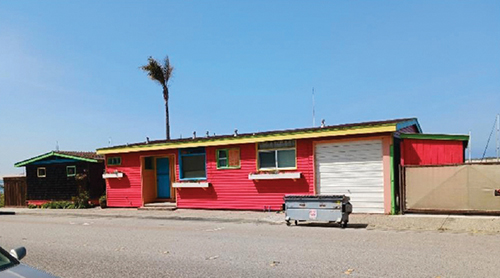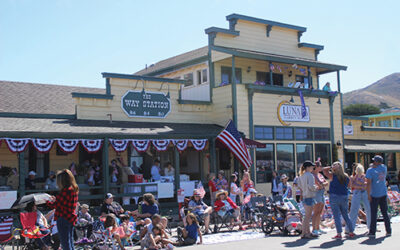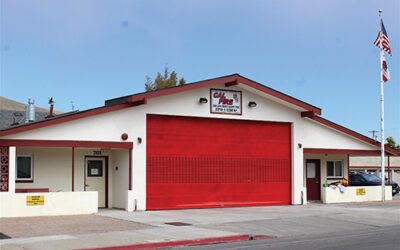The City of Morro Bay has put tidelands lease sites 50-50W and 51-51W along with lease site 49-49W out for redevelopment proposals. Shown here are the vacation rentals currently on the property. Photo submitted
Want to get your hands on a piece of the Morro Bay waterfront? This might be your chance.
In a fairly rare occurrence, the City of Morro Bay is putting up for lease a trio of Tidelands lease sites on the southern end of the Embarcadero seeking someone that will redevelop what are now bay front vacation rental units and vacant land.
The three lease sites include the land and water areas off the VRs, located at 451 Embarcadero, as well as the land and water areas next door, at 431 Embarcadero, that are currently vacant.
The 50-51/50W-51W sites had been leased to the late-Reg Whibley who lived in one and rented out the other. Though they aren’t for sale, the website Zillow lists the VRs with a value of $1.03 million but where they got that estimated value is unclear, as it is currently not for sale or rent.
These are among the few VRs on Tidelands Trust lands, which are owned by the State and leased to the City to manage for public benefit.
Revenues from the lease sites account for a majority of the revenues for the Harbor Department, which has fallen far behind in maintenance projects due mainly to a lack of money. During a 2022 push to pass a parcel tax of $120 a year on all private properties to support the harbor department (Measure B-22), which failed at the ballot box, it was estimated the harbor needs some $10 million in maintenance repairs.
The water leases at Sites 51-50 did have a side-tie dock/wharf where boats could tie up.

But the other site has been vacant for decades and would be a blank canvas for redevelopment. This isn’t the first time the City has tried to get someone to lease and build something on that site. A previous RFP that went out several years ago got zero takers, most likely because it is a very small lease site, with just 1,000 square feet of land out past the sidewalk and 2,500 s.f. in water area.
The site with the VRs is 2,000 s.f. of land area and 3,611 s.f. of water, so they are considerably bigger but still among the smallest of the dozens of lease sites the City controls and leases long term to business people.
Just what is the City looking to have built there? They’ve left that up to the potential bidders, with a few, broad guidelines.
“The Morro Bay City Council,” reads the RFP by Harbor Director Ted Schiafone, “has determined it is in the best interest of the City and public to consider redevelopment proposals for the Site. The City desires to have the Property redeveloped to continue to provide affordable visitor-serving opportunities that provide access to the bay, as well as an economic return to the City, while meeting modern design criteria that incorporate current planning and building codes for uses that are the most beneficial to the Embarcadero visitor-serving and business environments.”
Being so small, it probably makes sense to combine them to allow for a larger development footprint, but also likely severely limits what one might do there.
There’s one thing for sure, the City does know what it expects from a project. Among the “key objectives” are: the best and highest use of the land and water portions “to maximize revenues and return on investment.”
They want an improved view shed, beyond the single-story VRs on the site now that sit adjacent to the sidewalk, the front door to one unit literally a step off the 4-foot sidewalk.
The Council wants whatever is built to add to the tourism draw; restore and enhance the environment “where applicable;” and put in a public restroom, too — “if practical.”
The nearest public restrooms to these lease sites are at a small VR development a few doors down (571 Embarcadero), and at Tidelands Park to the south.
Any redevelopment will of course have to comply with the City’s various planning and zoning rules, as well as its Local Coastal Program.
And any project the City ultimately approves will automatically have to be reviewed and affirmed by the Coastal Commission, which has jurisdiction over all the so-called, Tidelands Trust lease sites.
That’s often where potential projects run into difficulty, as the Commission staff sometimes calls for things outside the City’s requirements, like when they expanded the required Harborwalk to 10-feet wide from the City’s standard 8-feet width.
This will be the first redevelopment of those sites in decades, and once a project receives conceptual approval by the City as part of the lengthy permitting process on the waterfront, the Harbor Department will begin discussing lease terms.
Among the design parameters are: minimum of 8-foot sidewalks and a 10-foot wide extension of the Harborwalk on the water side.
That would seem somewhat moot considering that the next lease site over is the Associated Pacific work dock and yard, which is not open for the public to stroll across and will likely never install that segment of Harborwalk, if and until it too gets torn down and redeveloped some day.
Three doors down is the Yacht Club, which is also not open for the public to cross, and isn’t likely to become part of the Harborwalk.
The new development(s) must be handicap-accessible throughout — adhering to Federal ADA rules and standards.
The City wants it to have a, “fishing village/marine heritage/working waterfront/national estuary” themes.
Potential uses are listed in the Municipal Codes (Section 17.24.170) and include: “Visitor-serving commercial and recreational uses,” including uses listed in Section 17.24.120.” “Retail Businesses” means “any establishment for the retail sale of any article, substance or commodity, but not including the warehousing or storage of lumber or other building materials, or the outdoor sale of used or secondhand goods or materials of any kind.”
Someone could also put in “retail and wholesale seafood markets and seafood processing” facilities, though the foot traffic along that stretch of the waterfront is pretty light.
They could build docks and slips for commercial or sport fishing uses but the Planning Commission before it approves something like that has to assess whether there is demand for it. Ordinarily, the City has a waiting list for commercial fishing slips.
Also, neither lease site has any existing parking, so whatever number of required parking spaces a new use/development might need would have to be covered in parking in-lieu fees, which are currently $15,000 per needed space.
The City decides via a complex formula, how many parking spaces each new use is required to provide on site, dependent on the type of use — restaurant vs. lodging vs. retail shops. And with restaurants, the capacity of the dining rooms determines how many spaces are needed.
Also, each new development negotiates its own lease deal with the City, which takes into consideration things like how much someone is spending when deciding how many years each should get.
The general rule of thumb for remodels/redevelopments has been 10 years for every $250,000 spent, with a cap at 50 years.
The RFP will take bids until Thursday, Oct. 5. After the close, the planning department will look them over to see if they comply with the rules and then the City Manager and Harbor Director will name a panel to go through and rate them.
The “Selection Panel” will be made up of City staffers, members of the public, and members of the Harbor Advisory Board.
They will narrow it down to the Top-2 that will then go to the City Council to pick a winner and sign a “Consent of Landowner” agreement, essentially giving permission to submit a project proposal for review and permitting.
The Consent of Landowner is necessary because Whibley’s lease on the VRs doesn’t run out until Summer 2025.



